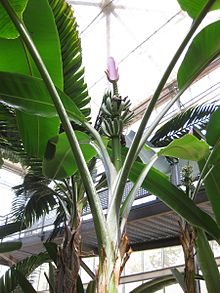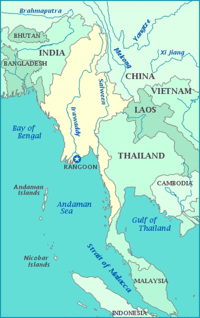- Musa ornata
-
Musa ornata Scientific classification Kingdom: Plantae (unranked): Angiosperms (unranked): Monocots (unranked): Commelinids Order: Zingiberales Family: Musaceae Genus: Musa Species: M. ornata Binomial name Musa ornata Musa ornata is one of more than 50 species of banana in the genus Musa. Most of these species are large perennial tropical herbs, mainly of lowland areas with high temperature and humidity. The Musa ornata originated in southeast Asia,[1] and is cultivated for its commercial and ornamental value.[2] Musa ornata has many common names in reference to the varying colors of its flowers including 'African Red', 'Bronze', 'Dusty Rose', 'Leyte White', 'Macro', 'Magenta', 'Pink', 'Purple', 'Red', 'Royal Pink', 'Royal Purple', 'Royal Red', and 'Red Salmon'. The fruit is attractive but tends to be inedible.[3]
Contents
Description
File:Musa Ornata Pink Banana.jpgMusa ornata.M. ornata belongs to the Musa subgenus Rhodochlamys. Rhodochlamys is one of the four sections into which the genus Musa is divided (the others being Australimusa, Callimusa and Eumusa, which is sometimes called Musa). As a member of Rhodochlamys, M. ornata has a basic chromosome number of 2n = 22 compared with 2n = 20 of the Australimusa and Callimusa. Plants of this section are known for their brightly colored bracts.[4]
The true M. ornata is found in India and is a small species. From its home in India it reached Central and South America early in the 19th century where it became naturalized. M. ornata is not an especially variable plant in itself but it hybridizes freely with other species. The result is that there are a number of hybrids derived from it in the tropical regions of America.[5]
Plants grow to a height of 5 to 10 ft (1.5 to 3.0 m). The plants have green foliage with pink tones throughout. The leaves can grow to be 6 ft (1.8 m) long, 14 inches (360 mm) wide and can be used for tropical cut flower arrangements. It produces pink flowers and small, dark pink or crimson fruit. The fruit type is a banana that is seeded and inedible.[6]
Musa ornata is a yellow-orange inflorence whose male and female flowers both tend to be 3-5 per bract in a single row, varying up to about 7 per cluster. The anthers of the male flowers are purple while the female style is green.
Distribution
M. ornata is native to south-east Asia and commonly found in Bangladesh, Burma, and India. This species is widely distributed throughout tropical regions but it is often misnamed. The plant is relatively tolerant and was found in Mauritius (off the coast of Madagascar) before 1805 and must have begun to travel several years before it was botanically described in 1824 on Indian banana plantations. Numerous parts of Mexico have also naturalized the plant, although the seedlings are often offered commercially under a different name (Musa violacea). .[7]
Uses
M. ornata is an ornamental perennial plant that is usually grown for decorative purposes. It flowers readily and produces few but viable seeds. The male bud may be cooked or used in salads, while the leaves are often incorporated in making dressings. The root of the plant is also sometimes used for ayurvedic preparations (alternative medicine) in northeast India. The ash of the pseudostem, the corm, the fruiting stalk and fruit peel are also used as an anti-scorbutic (to prevent scurvy), as well as for digestive help, or as a tonic.[8]
Notes
- ^ Tropilab Inc. - Musa ornata
- ^ Killer Plants - Plant of the Week 25 August 2003: Musa ornata.
- ^ Ornamental Bananas - Not Edible But Beautiful
- ^ Diversity in the genus Musa - Focus on Rhodochlamys
- ^ ENCANTO FARMS - Ornata
- ^ Rare Seed Source - Musa Ornata Dwarf Banana Purple Flower
- ^ Musa ornata
- ^ Bananas and People in the Homeland of Genus Musa:Not just pretty fruit- Jean Kennedy, published July 30, 2009.
Categories:- Bananas
- Musa
Wikimedia Foundation. 2010.


